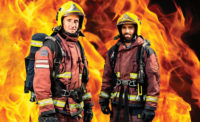Use of flame-resistant clothing (FRC) in industry has boomed in the past few years. Partly it’s due to OSHA requirements issued in 2014 mandating a large population of workers in the electric generation, transmission and distribution field be provided with FRC. The six-digit cost of one severe burn case is another factor. Plus, surging activity in the oil and gas business up until recently was accompanied by fatal work-related fires and explosions.
As the focus on FRC continues to grow, Mount Vernon FR, a U.S. manufacturer of flame resistant fabrics, sponsored a Voice of the Customer study in 2014 to better understand the challenges faced by EHS professionals. The study consisted of a focus group held at the 2014 ASSE Safety Conference in Orlando and an online survey distributed to ASSE members, with 400 safety, health and environmental professionals (representing almost 490,000 employees who wear FRC on the job) in the oil/gas, utilities, mining and construction industries providing answers.
Survey says
For starters, there is almost universal satisfaction among EHS pros with the level of protection provided by FRC now on the market. Almost nine in ten (88.1%) said protection is either not a problem at all (53.6%) or only a minor problem (34.5%).
Getting workers to wear FRC, something problematic with a variety of personal protection equipment (PPE) is also not much of an issue. Nearly eight in ten (76.0%) EHS respondents said employee compliance – defined as wearing FRC consistently and correctly – is either not a problem at all (35.5%) or that it is only a minor problem (40.5%).
According to the survey, here are the top five challenges EHS pros rated as a moderate or serious problem: 1) The need for more durable FRC to help manage costs and ensure safety; 2) Care and maintenance of FRC, especially during industrial laundering; 3) Finding FRC suitable for women; 4) Selecting FRC for inclement weather, such as rain gear; and 5) FRC for hot weather conditions.
Cost concerns
Nearly all respondents (95.5%) reported providing FRC to their employees, either exclusively (74.3%) or in combination with a stipend (21.2%). Durability issues can drive up costs -- the higher the FRC replacement rate, the higher the overall costs.
Oil and gas industry EHS pros were most concerned about FRC for inclement weather – 41.9% rated it a moderate or serious problem compared to 23.2% of those in the utilities and construction segments.
Balancing comfort and protection is a critical issue for FRC worn in hot weather conditions. Again, the oil and gas industry faces perhaps the biggest challenge here, due to extraction activity in the Southeast and Southwest U.S., where heat stress is a pervasive risk in the summer.
One more finding from the survey: most EHS pros do not believe FRC has become commoditized – 77% disagreed with the statement: “All FR fabrics are essentially the same.”
What’s the selection solution? Pros need to partner with FR fabric manufacturers, garment manufacturers and outside laundry services to meet the challenges of this growing area of PPE, according to the survey’s authors.
Source: “Understanding the Challenges of Managing an Effective Flame-Resistant Clothing Program,” a white paper for FRC users developed by Mount Vernon FR in conjunction with the American Society of Safety Engineers, September, 2014.







